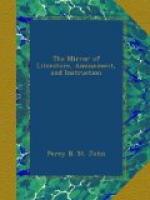“In the month of June, 1827,” says Mr. Cobbett, “my son and I slept one night in the same room in the garden-house at Barn-elm. The night was very hot, and neither his bed nor mine was cool enough to permit us to get to sleep, in a case like which, people generally get to talking; and I, in a mood, half between restlessness and laziness, asked him, whether Mr. Walker had planted his corn. He said he had; and that led him off into a train of arguing, the object of which was, to maintain his former opinion relative to the great benefits that would attend the cultivation of this crop. He entered into a calculation of the distances, the space of ground required by each plant, the number of plants upon an acre, the number of ears upon a plant, the quantity of seed upon an ear, ending in a statement of the amount of the crop per acre. He then dwelt upon the quantity and value of the fodder, upon the facility of cultivation, upon the small quantity of seed required for an acre; and, finally, upon the preparation which the growing of the crop would make for a succeeding crop of wheat.
“I do confess, that I was very hard to be convinced; I became interested to be sure, and I resolved to give the thing a trial immediately, if possible, or rather to set about it immediately; but, I confess, that if the thing had been urged upon me by almost any other person, I should not have done it. ‘Well, then,’ said I, ’William, we will give your little corn a trial, for it is not too late yet.’ But now a difficulty that appeared to be insuperable arose; namely, that the seed was all gone! The seed was all planted in Sussex. As soon as I reflected on this, I became really eager to make the experiment; so true it is, that we seldom know the full value of what we have had, till we have lost it. I recollected, however, that I had rather recently seen an ear or two of this corn in some seed-drawers that I had in the garden-house, not being quite sure, however, that they were of the true sort; and now I, who had so long turned from the subject rather with indifference, could not go to sleep for my doubts, my hopes, and fears, about these two bits of ears of corn. We had no light, or I should have got up to go and hunt the boxes, which I did as soon as day-light appeared, and there, to my great joy, I found two bits of ears of corn, which from the size and shape of the cobb, I knew to be of the true sort. This was upon the 8th of June in the morning.”
Indian corn is a kind of corn tree, so that it would be exempt from the sneer of the Tartars who despise the men that live on “the top of a weed.” The top of Indian Corn supplies the place of hay or of straw for fodder: it is the flower of the plant, and bears the farina like the wheat-ear, but the grains are deposited in the ears which come out of the stalk lower down. These ears are enveloped in their leaves which are called the husk. The number of ears varies in different plants, three is




